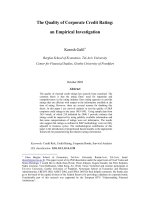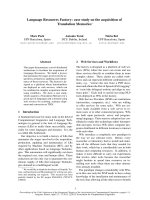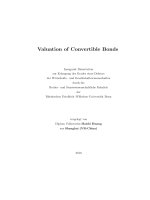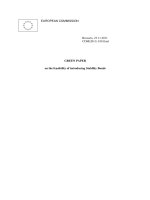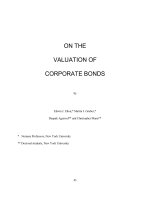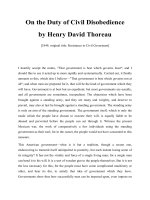ON THE VALUATION OF CORPORATE BONDS pot
Bạn đang xem bản rút gọn của tài liệu. Xem và tải ngay bản đầy đủ của tài liệu tại đây (383.68 KB, 52 trang )
43
ON THE
VALUATION OF
CORPORATE BONDS
by
Edwin J. Elton,* Martin J. Gruber,*
Deepak Agrawal** and Christopher Mann**
* Nomura Professors, New York University
** Doctoral students, New York University
1
The valuation of corporate debt is an important issue in asset pricing. While there has
been an enormous amount of theoretical modeling of corporate bond prices, there has been
relatively little empirical testing of these models. Recently there has been extensive development
of rating based models as a type of reduced form model. These models take as a premise that
groups of bonds can be identified which are homogeneous with respect to risk. For each risk
group the models require estimates of several characteristics such as the spot yield curve, the
default probabilities and the recovery rate. These estimates are then used to compute the
theoretical price for each bond in the group. The purpose of this article is to clarify some of the
differences among these models, to examine how well they explain prices, and to examine how
to group bonds to most effectively estimate prices.
This article is divided into four sections. In the first section we explore two versions of
rating-based models emphasizing their differences and similarities. The first version discounts
promised cash flows at the spot rates that are estimated for the group in question. The second
version uses estimates of risk-neutral default probabilities to define a set of certainty equivalent
cash flows which are discounted at estimated government spot rates to arrive at a model price.
The particular variant of this second model we will use was developed by Jarrow, Lando and
Turnbull (1997). In the second section of this paper we explore how well these models explain
actual prices. In this section we accept Moody’s ratings along with classification as an industrial
or financial firm as sufficient metrics for grouping. In the next section, we examine what
additional characteristics of bonds beyond Moody’s classification are useful in deriving a
2
homogeneous grouping. In the last section we examine whether employing these characteristics
can increase the precision with which we can estimate bond prices.
I. Alternative Models:
There are two basic approaches to the pricing of risky debt: reduced form models, of
which rating based models are a sub class, and models based on option pricing. Rating-based
models are found in Elton, Gruber, Agrawal, and Mann (1999), Duffie and Singleton (1997),
Jarrow, Lando and Turnbull (1997), Lando (1997), Das and Tufano (1996). Option-based models
are found in Merton (1974) and Jones and Rosenfeld (1984). In this paper we will deal with a
subset of reduced form models, those that are ratings based. Discussion of the efficacy of the
second approach can be found in Jones and Rosenfeld (1984).
We now turn to a discussion of the two versions of rating-based models which have been
advocated in the literature of Financial Economics and to a comparison of the bond valuations
they produce. The simplest version of a rating-based model first finds a set of spot rates that best
explain the prices of all corporate bonds in any rating class. It then finds the theoretical or model
price for any bond in this rating class by discounting the promised cash flows at the spot rates
estimated for the rating class. We refer to this approach as discounting promised payments or
DPP model. The idea of finding a set of risky spots that explain corporate bonds of a
homogeneous risk class has been used by Elton, Gruber, Agrawal and Mann (1999). While there
are many ways to justify this procedure, the most elegant is that contained in Duffie and
1
As shown in Elton, Gruber, Agrawal and Mann (1999), state taxes affect corporate
bond pricing. The estimated risk-neutral probability rates are estimated using spot rates. Since
spot rates include the effect of state taxes. These tax effects will be impounded in risk-neutral
probabilities.
3
Singleton (1997). They delineate the conditions under which these prices are consistent with no
arbitrage in the corporate bond market. We refer to the DPP model as a rating based model
under the reduced form category because, as shown in the appendix, DPP is equivalent to a
model which uses risk neutral default probabilities (and a particular recovery assumption) to
calculate certainty equivalent cash flows which are then discounted at riskless rates. To find the
bonds model price the recovery assumption necessary for this equivalency is that at default the
investor recovers a fraction of the market value of an equivalent corporate bond plus its coupon.
The second version of a rating-based model is the particular form of the risk-neutral
approach used by Jarrow, Lando and Turnbull (1997), and elaborated by Das (1999) and Lando
(1999). This version, referred to hereafter as JLT, like all rating based models involves
estimating a set of risk-neutral default probabilities which are used to determine certainty
equivalent cash flows which in turn can be discounted at estimated government spot rates to find
the model price of corporate bonds
1
. Unlike DPP, the JLT requires an explicit estimate of risk
neutral probabilities. To estimate risk neutral probabilities JLT start with an estimate of the
transition matrix of bonds across risk classes (including default), an estimate of the recovery rate
in the event of default, estimates of spot rates on government bonds and estimates of spot rates
on zero coupon corporate bonds within each rating class. JLT select the risk-neutral probabilities
so that for zero coupon bonds, the certainty equivalent cash flows discounted at the riskless spot
2
Many discussions of the JLT models describe this assumption as the recovery of
an equivalent treasury. The equivalence occurs because all cash flows are discounted at the
government bond spot rates.
4
rates have the same value as discounting the promised cash flows at the corporate spot rate. In
making this calculation, any payoff from default, including the payoff from early default, is
assumed to occur at maturity and the amount of the payoff is a percentage of par. This is
mathematically identical to assuming that at the time of default a payment is received which is
equal to a percentage of the market value of a zero coupon government bond of the same
maturity as the defaulting bond.
2
Thus, one way to view the DPP and JLT models is that they are
both risk neutral models but they make different recovery assumptions.
A. Comparison for zero coupon bonds
In this section we will show that for zero coupon bonds, the JLT and DPP procedures are
identical. We will initially derive the value of a bond using the JLT procedure.
To see how these models compare, we defined the following symbols:
1. be the actual transition probability matrix.
Q
5
2. be the actual probability of going from rating class i to default sometime over t
qt
id
()
periods and is the appropriate element of .
Q
t
3. be the probability risk adjustment for the t
th
period for a bond initially in rating
Π
i
t
()
class i.
4. be the risk adjusted (neutral) probability of going from rating class i to default at
At
i
()
some time over t periods. It is equal to .
Π
iid
tq t
() ()
5. be the price of a bond in rating class i at time zero that matures at time T.
V
iT
6. be the government spot rate at time zero that is appropriate for discounting cash
r
t
g
0
flows received at time t.
7. be the corporate spot rate at time zero appropriate for discounting the cash flow at
r
t
ci
0
time t on a bond in risk category i.
6
8. be the fraction of the face value for a bankrupt bond that is paid to the holder of a
b
i
corporate bond in class i at the maturity.
Since zero coupon bonds have cash flows only at maturity and since, for JLT model, recovery is
assumed to occur at maturity, we have only one certainty equivalent cash flow to determine. As
shown in Das (1999) or Lando (1999), the probability risk adjustment for this cash flow in the
JLT model is
Π
i
T
g
T
ci
T
iid
T
r
rbqT
()
()()
=−
+
+
ç÷
é
ë
ê
ê
ú
ú
−
1
1
1
1
1
0
0
Multiplying both sides of equation (1) by we find that is equal to
qT
id
(),
AT
i
()
(1)
()
()
()
AT
r
r
b
i
T
g
T
T
ci
T
i
()
=−
+
+
ê
ê
ú
ú
−
1
1
1
1
1
0
0
3
This also follows directly from noting that their results are equivalent to
discounting promised cash flows at spot rates.
4
Thus if bond pricing is the purpose of the analysis, the various estimation
techniques developed for estimating transition matrixes are vacuous in that they lead to identical
pricing. See Lando (1997)for a review of these techniques.
7
From examining the right-hand side of the equation, is independent of the value of
AT
i
()
Thus unlike JLT’s assertion, risk-adjusted probabilities are not a function of transition
qT
id
().
probabilities and , the results of their analysis are completely independent of the transition matrix
used to price bonds.
3
Risk-adjusted probabilities are only a function of the spot rates on
governments, the spot rates on corporates, and the recovery rate.
4
The risk-neutral price of a zero coupon corporate bond maturing after T periods in rating
class i where any payment for default is made at maturity is given by:
(2)
()
V
AT bAT
r
iT
z
iii
T
g
T
=
−+
+
100 1 100
1
0
(()) ()
where the superscript Z
has been added to to explicitly recognize that this equation holds
V
iT
only for zero coupon bonds. Substituting (1) into (2) yields
8
(3)
()
V
r
iT
z
T
ci
T
=
+
100
1
0
Thus, as stated earlier, employing the JLT methodology yields exactly the same model
price for any zero coupon bond (where payment for default only occurs at maturity) as
discounting the promised cash flow at the corporate spot rates that were used as input to the
analysis. If the only bonds we were interested in were zero coupon bonds where payment for
default occurred at maturity, it would not matter in terms of pricing bonds whether we discounted
promised payments at the corporate spot rate or used the JLT procedure. Why, then, bother with
both models? The reason is that they produce very different answers if we examine coupon-
paying bonds, or in fact any bond where the pattern of cash flows in any period is different from
that of a zero coupon bond that pays off as a percentage of par in default at the horizon.
B. Comparison for Coupon Bonds
If we examine a two-period bond with a coupon of c dollars, the value of the bond using
the corporate spot rate to discount promised payments is
(4)
()
()
V
c
r
c
r
i
ci
ci
2
01
02
2
1
100
1
=
+
+
+
+
5
JLT assume that at bankruptcy the investor recovers a fraction of the face value of
the bond at the horizon or equivalently an amount equal to the fraction of an equal maturity
government bond at the time of bankruptcy. In the appendix we show that if an investor recovers
an amount equal to a fraction of the market value of an equal maturity corporate bond in the same
risk class plus the same fraction of the coupon, then the risk-neutral valuation gives the same
valuation as discounting promised cash flows at corporate spot rates.
6
This is the procedure employed by JLT. An alternative might be to solve for the
factor that produced the same value for a bond with an average coupon. However, since the
9
Using risk-adjusted probabilities and continuing the assumption that the recovery of cash
flows on defaulted bonds occurs at the maturity of the bond.
5
(5)
()
()
[]
()
V
cA
r
cAbA
r
i
i
g
iii
g
2
01
02
2
11
1
100 1 2 100 2
1
=
−
+
+
+− +
+
(())
( ) () ()
It is easy to see that these two equations (4) and (5) are not equal to each other for the
definition of risk adjustment given by equation (1), and in fact that there is no risk-adjustment
expression that will equate them for a group of coupon paying bonds with different coupons
using JLT’s assumption about recovery.
However, we can be more precise concerning the direction of the differences. We will
now show that the JLT procedure will produce model prices which are lower for coupon paying
debt than those produced by discounting promised cash flows at corporate spot rates. The JLT
risk adjustment factor was arrived at by finding the factor that produced the same value for zero
coupon debt as discounting promised cash flows at the corporate spot rate.
6
correct factor in the JLT procedure is a function of coupon, this would misprice bonds in a
manner analogous to that shown in the following analysis.
7
All our empirical work uses continuous compounding. However, it is easier to
follow the discussion, and the comparisons are more obvious, using discrete compounding.
10
The risk-neutral valuation of zeros is
()
()
V
AT bAT
iT
z
iii
T
T
=
−+
1 100 100() ()
1+r
0
g
The valuation from discounting promised cash flows is
()
V
r
iT
z
T
ci
T
=
+
100
1
0
Equating the two and solving for
7
AT
i
()
(6)
()
()
()
AT
r
r
b
i
T
g
T
T
ci
T
i
()
=−
+
+
ç
ç
÷
÷
−
1
1
1
1
1
0
0
11
Note this is identical to the definition of from Das (1999) and Lando (1999) presented
AT
i
()
earlier.
If there was a coupon in the last period, the present value of the last period’s cash flow
would be
()
()
()
v
AT c bAT
r
iT
iii
OT
g
T
=
−++
+
1 100 100
1
() ()
Where the lower case v indicates it is the present value of a single cash flow rather than the
complete bond value.
Discounting the last period’s promised cash flow at the corporate spot rate yields
()
v
c
r
iT
T
c
T
=
+
+
100
1
0
Equating these two equations and solving for yields
AT
i
()
12
(7)
()
()
AT
r
r
b
c
i
T
g
T
T
ci
T
i
()
=−
+
+
ç
ç
÷
÷
−
+
æ
è
ç
ö
÷
1
1
1
1
1
100
100
0
0
If we examine the cash flows for any period prior to the period in which a bond matures,
the present value of the t
th
period cash flow using risk-neutral probabilities is
()
()
v
At c
r
it
i
t
g
t
=
−
+
1
1
0
()
and for promised cash flows the present value of the t
th
period cash flow is
()
v
c
r
it
t
ci
t
=
+
1
0
Equating and solving for yields
At
i
()
(8)
()
()
At
r
r
i
t
g
t
t
ci
t
()
=−
+
+
ç
ç
÷
÷
1
1
1
0
0
8
See Duffie and Singleton (1997) for a detailed discussion of assumptions under
which it is exactly correct to discount promised payments at spot rates. See Appendix A for a
discussion of the recovery assumption necessary for discounting promised cash flows at the spot
rate to be the same as risk-neutral valuation.
13
By inspection, equation (6) results in a higher value for any than equation (7) or
At
i
()
(8). Thus using zeros to define under the JLT procedure leads to estimates of that
At
i
()
At
i
()
are larger than those obtained by determining using coupon paying bonds. From equation
At
i
()
(5) using higher results in lower prices. Thus using the JLT procedure will always result
At s
i
()'
in lower estimated prices than discounting promised cash flows at corporate spot rates. Later we
will estimate and examine the size of this difference for coupon paying corporate bonds.
Since the JLT methodology leads to different values for coupon-paying corporate debt
than discounting promised cash flows at corporate spot rates, the question remains as to which
provides more accurate valuation. Discounting promised payments at corporate spot rates is an
approximation except under restrictive conditions. The defense of using spots is an arbitrage
argument, and the arbitrage argument in terms of promised payments is an approximation which
is only exactly correct under certain assumptions.
8
On the other hand, the structure of the JLT
model insures that coupon paying bond prices can’t be reproduced exactly even over a fit period.
The choice between these models then becomes an empirical matter, one to which we now turn.
II. TESTING THE MODELS
9
The only difference in the way CRSP data is constructed and our data is
constructed is that over the period of our study CRSP used an average of bid/ask quotes from five
primary dealers called randomly by the New York Fed rather than a single dealer. However,
comparison of a period when CRSP data came from a single dealer and also from the five dealers
surveyed by the Fed showed no difference in accuracy (Sarig and Warga, (1989)). See also the
discussion of pricing errors in Elton, Gruber, Agrawal and Mann (1999).Thus our data should be
comparable in accuracy to the CRSP data.
14
A. DATA
Our bond data is extracted from the Lehman Brothers Fixed Income database distributed
by Warga (1998). This database contains monthly price, accrued interest, and return data on all
investment grade corporate and government bonds. In addition, the database contains descriptive
data on bonds including coupon, ratings, and callability.
A subset of the data in the Warga database is used in this study. First, any bond that is
matrix-priced rather than trader-priced in a particular month is eliminated from the sample for
that month. Employing matrix prices might mean that all our analysis uncovers is the formula
used to matrix price bonds rather than the economic influences at work in the market.
Eliminating matrix priced bonds leaves us with a set of prices based on dealer quotes. This is the
same type of data contained in the standard academic source of government bond data: the CRSP
government bond file.
9
10
Slightly less than 3% of the sample was eliminated because of problematic data.
The eliminated bonds had either a price that was clearly out of line with surrounding prices
(pricing error) or involved a company or bond undergoing a major change.
15
Next, we eliminate all bonds with special features that would result in their being priced
differently. This means we eliminate all bonds with options (e.g., callable or sinking fund), all
corporate floating rate debt, bonds with an odd frequency of coupon payments, government
flower bonds and index-linked bonds. Next, we eliminate all bonds not included in the Lehman
Brothers bond indexes because researchers in charge of the database at Shearson-Lehman
indicated that the care in preparing the data was much less for bonds not included in their
indexes. Finally, we eliminate bonds where the data is problematic.
10
For classifying bonds we
use Moody’s ratings. In the few cases where Moody’s ratings do not exist, we classify using the
equivalent S&P rating.
B. Testing the Approaches
In this section we discuss the comparison of model errors produced by discounting
promised cash flows at corporate spot rates with those produced by discounting risk-adjusted
cash flows at the riskless government rates.
Calculating model prices using the discounting of promised cash flows is relatively
straightforward. First, spots rates must be calculated. In order to find spot rates, we used the
11
See Nelson and Siegal (1987). For comparisons with other procedures, see Green
and Odegaard (1997) and Dahlquist and Svensson (1996). We also investigated the McCulloch
cubic spline procedures and found substantially similar results throughout our analysis. The
Nelson and Siegal model was fit using standard Gauss-newton non-linear least squared methods.
The Nelson and Siegal (1987) and McCulloch (1971) procedures have the advantage of using all
bonds outstanding within any rating class in the estimation procedure, therefore lessening the
effect of sparse data over some maturities and lessening the effect of pricing errors on one or
more bonds. The cost of these procedures is that they place constraints on the shape of the yield
curve. We used Moodys categories where they existed to classify bonds. Otherwise we used the
equivalent S&P categories.
16
Nelson Siegal (1987) procedure for estimating spots from a set of coupon paying bonds. For each
rating category, including governments, spots can be estimated as follows:
11
D
t
e
r
t
t
=
−
0
()
raaa
e
at
ae
to
at
at
012
3
2
1
3
3
=+ +
−
êú
−
−
−
Where
is the present value as of time zero for a payment that is received t periods in the future
D
t
is the spot rate at time zero for a payment to be received at time t
r
t
0
12
For a discussion of historical rates see Elton, Gruber, Agrawal and Mann (1999).
We us continuous compounding in estimating risk neutral possibilities.
17
are parameters of the model
aaa a
012 3
, , and
Discounting the promised cash flows at these estimated rates produces the model prices
for this technique.
The estimation for the JLT procedure is more complicated. The first step is to estimate
risk-neutral probabilities based on equation (1). So that the models can be directly compared, we
use the same estimated spots that were used to discount promised cash flows as input to equation
(1). We used historical recovery rates for Aa, A, and Baa rated corporate bonds.
12
In Table I we report the risk-adjusted probabilities we arrive at using this procedure.
While risk-adjusted probabilities are derived each month, in the interest of brevity we report
them once a year (January) for each year in our sample period and only for industrial Baa bonds.
It is interesting that the risk-neutral probabilities we arrive at are quite well-behaved relative to
the risk-neutral probabilities reported by other authors (e.g., Jarrow, Lando, Turnbull (1997). In
particular, our risk-neutral probabilities are all positive, and increase with maturity. We attribute
the greater plausibility of our results to the large sample we use as well as the procedure we
employ to extract spot rates.
18
As shown earlier, if one uses the JLT model, the risk-adjusted probabilities from zero
coupon bonds should understate the price of any coupon-paying bond. In addition, we would
expect that the absolute errors (a measure of dispersion) should be higher for the errors
themselves should be function of the coupon and coupons vary within any rating class.
Table II shows that the empirical results are consistent with the implications of the theory.
Note, as shown in Table II Panel A, that when bonds are priced by discounting promised
payments at corporate spot rates, the average error for each class of bonds is very close to zero
and overall the average error is less than one cent per $100 bond. When we look at the average
pricing errors from the JLT procedure, we see that they are negative and quite large for any class
of bonds. Errors are measured as JLT model price minus invoice price. The negative error shows
that the JLT procedure applied to coupon-paying bonds understates their market value. In
addition, as shown in Table II Panel B the average absolute error is much higher for the JLT
procedure. The average absolute error is affected by both the mean error and the dispersion
across bonds. Table 2C corrects for the mean error by computing the average absolute error
around the mean. Since the average error for DPP is close to zero, this correction has little effect
on DPP and the average absolute errors in 2B and 2C are similar. Since there is a large mean
error for JLT, calculating average absolute errors around the mean does make a difference for
JLT. Even after this correction, however, absolute JLT errors are much higher than absolute DPP
errors. Thus, the JLT procedure not only has a mean bias, but also results in greater dispersion of
errors around the mean across bonds. These results are exactly what our analytical examination
of the models lead us to expect.
19
It is worth examining one more point before we end this section. We would not expect
the average error to be a function of maturity when we discount promised payments. With the
JLT procedure we would expect the error to increase as maturity increases. This pattern occurs
because each coupon is systematically undervalued and the more coupons a bond pays, the larger
the mispricing. This is exactly what happens, as shown in Table III. For example, for the JLT
procedure applied to BBB industrial bonds, the error increases from thirteen cents per $100 to
over $3 per $100 as maturity increases.
In the next section of this paper we examine the ability of additional bond and/or
company characteristics to improve the pricing of corporate bonds. We will conduct this
examination employing the model which discounts promised cash flows at a rate which is
appropriate for the risk of the promised payments rather than the JLT model since it produced
lower errors.
III. Getting a Homogeneous Sample
When estimating spot rates, one has to make a decision as to how to construct a group of
bonds that is homogeneous with respect to risk. In the prior section we accepted the major
classifications of rating agencies. In this section we explore the use of additional data to form
more meaningful groups.
20
In general, when dividing bonds into subsets, one faces a difficult tradeoff. The more
subsets one has, the less bonds are present in any subset. Bond prices are subject to idiosyncratic
noise as well as systematic influences. The more bonds in a subset, the more the idiosyncratic
noise is averaged out. This suggests larger groupings. However, if the subset is not
homogeneous, one may be averaging out important differences in underlying risk and mis-
estimating spot rates because they are estimated for a group of bonds where subsets of the group
have different yield curves.
What are the characteristics of bonds that vary within a rating class that could lead to
price differences? We will examine the following possibilities:
(A) Default risk
(B) Liquidity
(C) Tax liability
(D) Recovery rates
(E) Age
A. Differential Default Risks:
13
For all bonds rated by Moodys we use Moodys’ classification. For the few bonds not
rated by Moody’s, we use S&P’s classification.
21
All bonds within a rating class may not be viewed as equally risky. There are several
characteristics of bonds which might be useful in dividing bonds within a rating class into new
groups. We will examine several of these in this section. We start by examining the subcategories
of risk within a rating class which Moodys and Standard & Poors have both introduced. We then
examine whether either past changes in rating category or a difference in rating by Standard &
Poors and Moodys convey information.
We start by examining the finer breakdown of ratings produced by the rating agencies
themselves. Standard & Poors and Moodys have introduced plus and minus categories within
each letter rating class. One obvious possibility is that bonds that are rated as a plus or a minus
are viewed as having different risk than bonds that receive a flat letter rating. If this is true, then
estimating one set of spot rates for all bonds in a class should result in consistent pricing errors
for bonds rated “plus” (too low a model price and hence negative errors) or bonds rated “minus”
(too high a model price and hence positive errors).
Tables IVA and IVB explore this possibility. For each rating class the table is split into
two sections. The top section shows the number of bond months in each rating class for varying
maturity and across all maturities.
13
The bottom section shows the average of the model price
minus the invoice price (market price plus accrued interest) for each rating category. For all
rating categories, plus-rated bonds have, on average, too low a model price, and minus-rated
22
bonds too high a model price. The difference between the pricing error of plus rated, flat, and
negative rated bonds is statistically significant at the 5% level. Furthermore, the differences are
of economic significance (e.g., for minus versus flat Baa industrial bonds the difference is almost
1% of the invoice price). The same pattern is present for most of the maturities. In addition, the
size of the average pricing error increases as rating decreases. Thus, it is most important for Baa
bonds. This would suggest that one should estimate a separate spot curve for these subclasses of
ratings. However, for much of the sample, the paucity of bonds in many of the subclasses makes
it difficult to estimate meaningful spot rates for a subclass. Instead, we propose to directly
estimate the price impact of the finer gradation of rankings on errors (which is a function of
maturity). The ability to correct the model price for these differences will be examined in the
next section.
There is a second reason why investors might consider bonds within the same rating class
to have different risk. Investors might believe that a particular bond is likely to be downgraded or
upgraded. One predictor of this might be past rating changes. Past rating changes might predict
future rating changes, either because rating agencies tended to make changes in steps or because
a company whose risk has increased or decreased in the past is more likely to experience similar
changes in the future. In Table V we explore whether past rating changes contain information
about future rating changes. As shown in the table, bonds that have been upgraded in the past are
more than twice as likely to be upgraded in the future than they are to be downgraded, and bonds
that have been downgraded in the past are about twice as likely to be downgraded than upgraded
in the future.
23
Although there is evidence that past rating changes predict future rating changes, it is
unclear if the tendency is strong enough to show up in price data. We examined differences
between model price and invoice price for all bonds which had a past change in ratings. Pricing
errors were examined in the month of the change, the next three months after the change, and the
period 4 to 15 months after the change. These results are shown in Table VI. Despite the fact that
past rating changes contain information about future rating changes, we find no evidence that
bonds with past rating changes have prices that are systematically different from model prices.
Our sample of bonds with rating changes was quite small, for there were few bonds which had
rating changes. Thus the failure to find a relationship between past rating changes and errors
could arise either because investors do not take the predictability of past rating changes into
account when they price bonds, or simply because the number of rating changes is so small that
the effect is swamped by random pricing errors. In any case, examining past rating changes
provides no evidence that the Markoff assumption used in calculating the transition probability
matrix found in many studies is violated.
In Table VII we explore whether bonds that are given a higher (lower) rating by S&P than
by Moody’s are considered less (more) risky by investors. In considering differences we use
pluses and minuses. Thus, if Moodys rates a bond as Baa and S&P rates the bond BBB+, we
count this as a difference in ratings. Once again the upper half of the table shows the number of
bonds in each category, and the lower half the difference between model price and invoice price.
In presenting the data we do not sub-classify by maturity since we found no pattern in pricing
errors across maturity.
24
Investors clearly take the difference in rating into account. If the S&P rating is lower than
Moodys, then investors act as if the bond is higher risk than is implied by the Moodys rating and
they will set a lower market price, and this results in a model price above invoice price and a
positive error. Likewise, if S&P rates the bond higher than Moodys the bond is considered by
investors as lower risk compared to bonds where they agree and the pricing error is negative. The
errors when the rating agencies disagree is statistically different from the errors when they agree.
B. Different Liquidity
The second reason why bonds within a rating class might be valued differently is because
they have different liquidity. Data is not available on bid/ask spread, the most direct measure of
liquidity, nor is there data on trading volume which is a natural proxy for liquidity. Thus we had
to use two indirect measures of liquidity: volume outstanding and percentage of months a bond
was matrix priced. Our logic behind the latter measure was that dealers priced the more active
issues more often. Thus bonds that were always dealer-priced were likely to be more liquid than
bonds that were dealer-priced only part of the time. Neither of these measures showed any
significant patterns, and so we have not presented a table of results. Thus while there may be
liquidity differences between bonds, and these may be priced, we are unable to find reasonable
proxies to demonstrate this influence.
C. Different Tax Treatment
